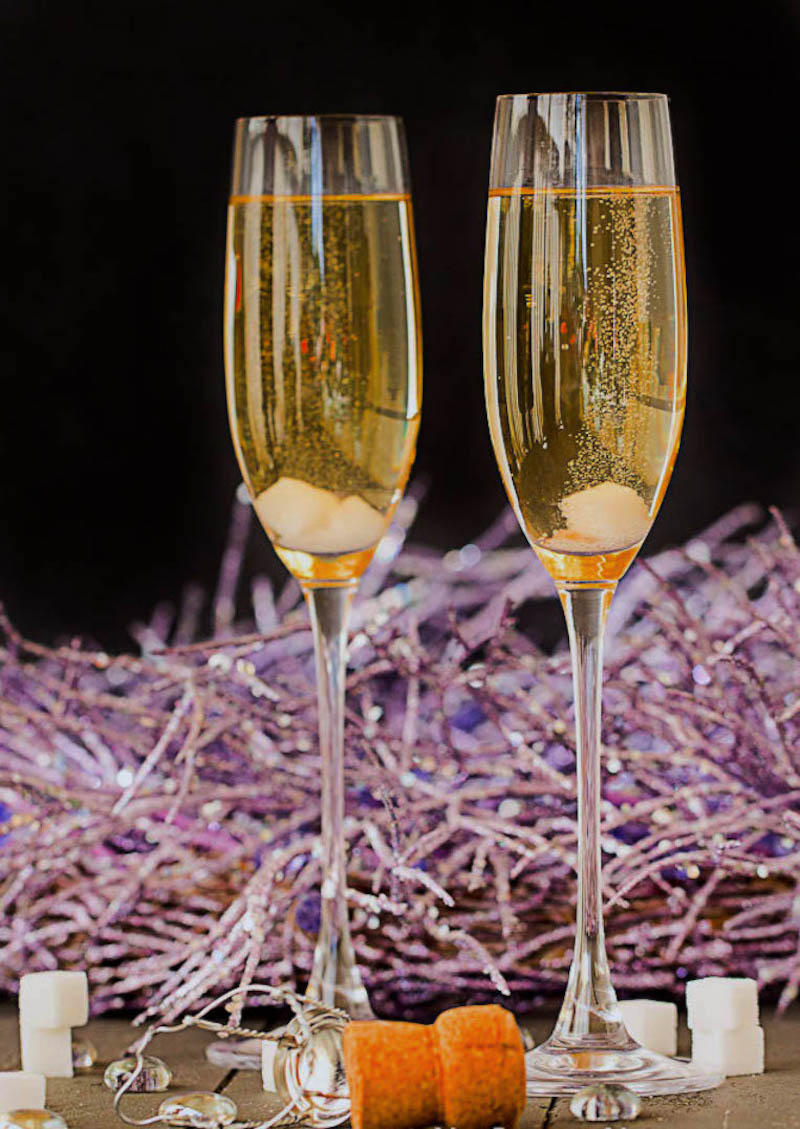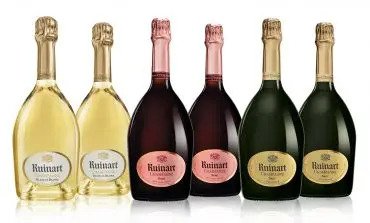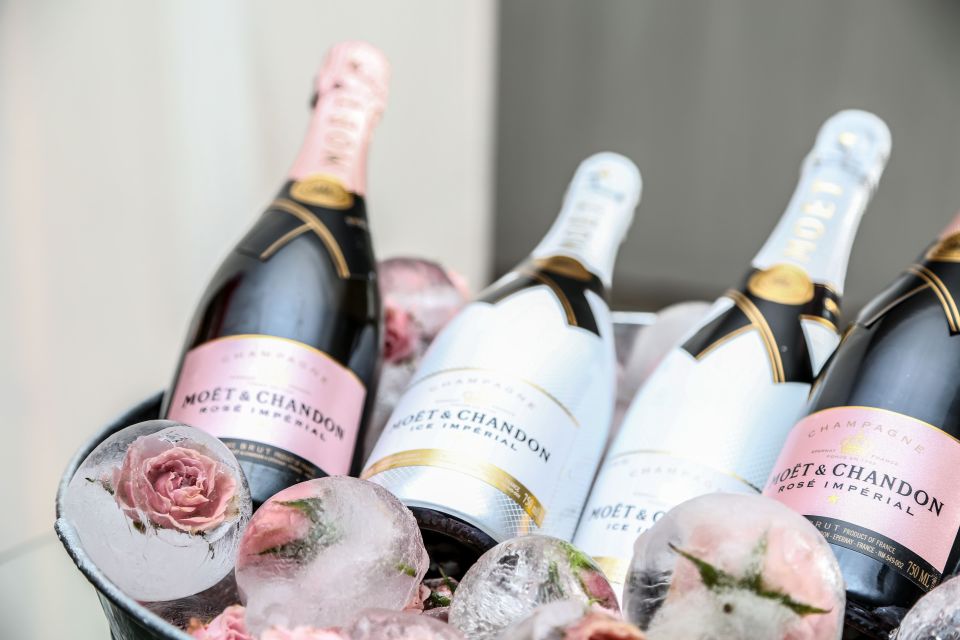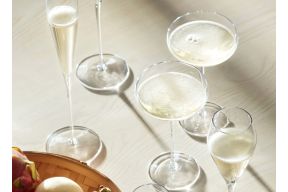Not only are there different types of Champagne, but this wonderfully bubbly beverage also comes in various styles. Each of these are categorised by sweetness level, ageing and vintage level, and regional classification.
Table of Contents
- Champagne by sweetness levels
- The different styles of Champagne
- Champagne ageing categories
- Champagne regional classification
- So, to summarise...
Champagne by sweetness levels

Image courtesy: Honestcooking.com
Champagne has three main categories of sweetness levels: Brut, Demi-Sec, and Doux. This level is determined by the sugar dosage, which is the amount of sugar added to the wine during the making of Champagne. This sugar solution, known as liqueur d'expédition, is added to adjust the final sweetness level of the wine. The grape variety, the terroir and the ageing process can also influence the sweetness level of Champagne.
Brut Nature Champagne
Brut Nature Champagne, or Zero Dosage Champagne, is a very dry style of Champagne with little or no sugar — less than 3g per litre. It is made from a blend of chardonnay, pinot noir, and pinot meunier grapes. It’s crisp and fruity flavours make it an excellent apertif and pairs very well with seafood such as sushi or oysters, light cheeses, pate, and appetisers such as cured meats and canapes.
Extra Brut Champagne
Extra Brut Champagne is another dry style of Champagne but slightly sweeter with less than 6g per litre of sugar and made from a blend of pinot noir, chardonnay and pinot meunier grapes. While Extra Brut Champagne is best enjoyed as an aperitif, it can also stand up very well to being paired with rich, flavourful dishes such as foie gras, salty foods such as caviar, oysters or sushi and cured meats.
Brut Champagne
One of the most popular Champagne types is Brut, a fairly dry wine with a slightly sweeter taste and a residual sugar level of less than 12g per litre. Blended from the same grapes as Brut Nature and Extra Brut, Brut Champagne is a great accompaniment to dishes that aren't overly sweet. Brut Champagne pairs well with sweet, salty and mature cheeses, oysters and fried food dishes.
Extra Sec Champagne
Extra Sec Champagne is slightly sweeter than Brut but still considered dry. It contains 12-17 grams of sugar per litre. It is considered a medium-dry style of Champagne and a good alternative for those who find Brut Champagne too dry. Extra Sec Champagne combines fruit, floral and mineral notes with a hint of sweetness and is a good choice for those who want a slightly sweeter Champagne that can be paired with various dishes. Extra Sec Champagne is a great accompaniment to spicy dishes such as Mexican or Thai cuisine, grilled or roasted meats, shellfish including scallops or crab, brie or blue cheese and fried foods such as spring rolls or tempura.
Sec Champagne
Sec Champagne is considered a semi-sweet style of Champagne with a residual sugar level between 17 and 32g of sugar per litre. It's sweeter than Extra Sec Champagne but less sweet than Demi-Sec Champagne and pairs well with food that's not too salty or sweet. Serve Sec Champagne with aged cheese to balance out the punchy and salty flavours of the cheese, alongside a rich pate or with a fruit tart.
Demi-Sec Champagne
Demi-Sec Champagne is a semi-sweet style of Champagne which contains between 32 and 50 grams of sugar per litre. It's sweeter than Sec Champagne but less sweet than Doux Champagne. Characterised by its moderate sweetness and fruity aroma with notes of citrus, apple, pear, and white peaches, it can be enjoyed as an aperitif or paired with desserts with strong and sweet flavours such as chocolate, caramel or fruit tarts.
Doux Champagne
Doux Champagne is the sweetest style of Champagne, with 50g of sugar per litre. It's characterised by its high sweetness and fruity notes of citrus, apple, pear, and white peaches and a creamy texture with a good balance of acidity and sweetness, with flavours of biscuit, toast, and a hint of honey. The finish is crisp and clean, with a subtle sweetness that lingers. It's best enjoyed as a dessert wine paired with sweet or rich desserts. It's sweeter than Demi-Sec Champagne.
The different styles of Champagne

There are several styles of Champagne, each with its distinct flavour profile and sweetness level.
Blanc de Blancs Champagne
Blanc de Blancs Champagne is a sparkling wine made entirely from chardonnay grapes grown in the Champagne region of France. "Blanc de Blancs" translates to "white from whites," meaning it is made from white grapes. Known for its delicate, refined, elegant taste, high acidity, and light body. It is characterised by its delicate aromas of citrus and white flowers, flavours of green apples, pears, and a hint of brioche. The wine is usually made using the traditional method. It’s fermented in the bottle, it goes through a secondary fermentation process known as the Méthode Champenoise, which gives it its wonderful bubbles. Because of its citrusy aroma, it pairs well with seafood and oysters.
Blanc de Noirs Champagne
Blanc de Noirs Champagne is a type of Champagne that is made exclusively from black grapes, typically pinot noir or pinot meunier. The grapes are pressed and fermented, and the resulting wine is then blended with reserve wines. It is then bottled with a small amount of sugar and yeast to undergo a second fermentation in the bottle. This process creates the bubbles and effervescence for which Champagne is best known. Blanc de Noirs Champagne is typically characterised by its full body and rich, complex flavour profile, with notes of red fruits, such as strawberry and raspberry. It pairs fantastically with red meats, strong cheeses and dark chocolate.
Rosé Champagne
Rosé Champagne is mainly made by blending red and white wine. The red wine is made from pinot noir or pinot meunier grapes, which are crushed and left in contact with their skins for a brief time to give the wine its pink colour. The white wine is from chardonnay grapes. The two wines are then blended and bottled with a small amount of sugar and yeast to undergo a second fermentation to create bubbles. Rosé Champagne is typically characterised by its delicate pink colour, crisp acidity and fruity flavour profile, with notes of red fruits such as strawberry, raspberry, and cherry. It pairs well with seafood, poultry, and fruity desserts.
Organic Champagne
Organic Champagne is made using grapes grown without synthetic pesticides and fertilisers using the traditional method of second fermentation in the bottle. Typically, it is characterised by its bright acidity, fruity aroma and delicate flavour. The flavour and aroma can vary depending on the grape varieties used, but it is usually fresher, more vibrant and less intense than conventional Champagne. It pairs well with seafood as well as poultry and vegetables.
Vegan Champagne
Vegan Champagne is made without animal-derived products, such as isinglass (a type of fish gelatin) and casein (a protein found in milk), commonly used as fining agents to clarify the wine. The production process of vegan Champagne is similar to that of its traditional counterpart, which involves a secondary fermentation in the bottle. Vegan Champagne tastes like traditional Champagne, with citrus, apple, bread, bubbles, and effervescence notes. It pairs well with a variety of foods, including seafood, vegetables, and poultry, as well as vegan dishes.
Champagne ageing categories
The ageing process allows the Champagne to develop complexity, depth and elegance, affecting the final product's taste, aroma, and character. Vintage Champagne ages for at least three years before being sold, while multi-vintage Champagne is made by blending grapes from different years, and non-vintage Champagne is aged for only 15 to 18 months. The ageing category affects the price of the Champagne, with prestige cuvée, vintage and aged Champagnes being more expensive than non-vintage.
Non-Vintage Champagne
Non-vintage Champagne is a type of Champagne that is made by blending grapes from different years, typically 2 or 3 years. The aim is to create a consistent taste and style from one year to another. The varieties of grapes used to make non-vintage Champagne are the same as those used for vintage and multi-vintage Champagne: chardonnay, pinot noir, and pinot meunier. These varieties are blended in different proportions and from different years to create a consistent expression of the house's style, year after year.
Vintage Champagne
Vintage Champagne is made from grapes harvested in a single year and aged for at least three years before release. The varieties of grapes used to make vintage Champagne are the same as those used for non-vintage Champagne. The grapes are blended together in different proportions to create the desired style of Champagne for that year. The specific vintage year and the blend of grapes used will affect the final taste, aroma and character of the Champagne, making each vintage unique.
Multi-Vintage Champagne
Multi-vVintage Champagne is made from a blend of grapes harvested over multiple years and aged for at least three years before release. It won't have the unique characteristics of a single vintage year but has a consistent taste, aroma and character for which the house is known. The varieties of grapes used to make multi-vintage Champagne are the same as those used for non-vintage and vintage Champagne. These are blended in different amounts and from different years to create a consistent expression of the house's style.
Champagne regional classification
The Champagne region in France is made up of four main areas, or "crus," for classifying its sparkling wines. These are the Côte des Bar, the Côte des Blancs, the Montagne de Reims, and the Vallée de la Marne. Each area has its own unique soil and climate conditions, which contribute to the distinct characteristics of the wines produced there. The wines produced in each area are also subject to specific regulations, such as grape variety, yields and ageing time. To be labelled Champagne, a wine must meet these strict criteria and pass a tasting examination by a committee.
The Échelle des Crus, or "ladder of growth," is a classification system used to categorise the various villages and vineyards in the Champagne region of France. It is based on the perceived quality and prestige of the wines produced in each area, alongside soil quality, the vineyard's reputation, and the area's historical significance. It includes three levels: Grand Cru, Premier Cru, and Autre Cru.
Grand Cru
Grand Cru is the highest classification for Champagne, awarded to the best vineyards based on reputation and historical significance. These vineyards have the best terroir, or combination of soil and climate conditions, for producing high-quality grapes, translating into the region's finest and most sought-after Champagne. Those produced from these vineyards are often considered to be of the highest quality, with a high price point to match. Of the 17 Grand Cru parcels or communes, 11 are located in the Montagne de Reims and 6 in the Côte des Blancs.
Premier Cru
Premier Cru is the second-highest classification for Champagne. It is awarded to vineyards with a reputation and historical significance for producing high-quality grapes. These vineyards have a good terroir, or combination of soil and climate conditions, for producing grapes that translate into high-quality Champagne. Not all Champagnes produced in Premier Cru vineyards are of the same quality, as the terroir and winemaking techniques vary greatly between villages. The classification is reviewed every ten years to ensure that it reflects the current quality of the Champagnes produced in each village. The Premier Cru champagne designation is only given to wines blended from grapes grown in an parcel, area (or commune) classified as Premier Cru in the Champagne region. The Premier Cru champagne appellation has only been awarded to 44 areas (communes) out of the 319 that make up the vineyards.
Autre Cru
As part of the Échelle des Crus, or "ladder of growth" system, Autre Cru is the lowest classification for Champagne. These vineyards are considered to have a good terroir but not as good as the Grand or Premier Cru vineyards. The classification is given to villages with only a minority or none of their vineyards classified as Grand or Premier Cru. Champagnes produced from these vineyards are of good quality but don't have the same complexity or ageing potential as those from the higher classifications.
So, to summarise…
There is so much more to Champagne than meets the eye (or tastebuds). There are several Champagne types, including Brut, Extra Dry, Demi-Sec, and Doux, based on the dosage of sugar added after the secondary fermentation, with Brut being the driest and Doux being the sweetest.
Champagne can also be classified by grape varieties and production methods such as Non-vintage, Vintage and Rosé. Our comprehensive Champagne Guide explains more about Champagne's different varieties and features.



